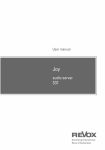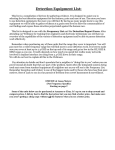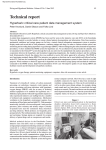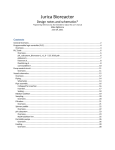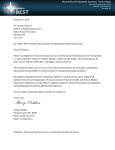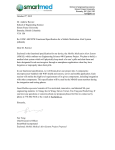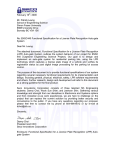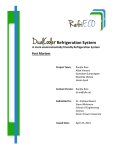Download Sam Leung Sam Leung - School of Engineering Science
Transcript
February 8, 2010 Dr. Andrew Rawicz School of Engineering Science Simon Fraser University Burnaby, British Columbia V5A 1S6 Re: ENSC 440 Functional Specifications for a Wireless Weight Distribution Scale Dear Dr. Rawicz: The following document contains the functional specifications for Asäna's Wireless Weight Distribution Scale. The scale will be used to measure the user's body weight and center of balance. This information can be used for a wide range of health related applications. For example, a recovering stroke patient needs to relearn how to stand with an even weight distribution between both feet. The scale will wirelessly send the collected information to a nearby computer for data storage and analysis. High level requirements are outlined in the functional specifications that cover both the development and production phases. These specifications will help keep our development phase on task and in line with our goals. It will also serve as a tabulation on tasks that our team has completed to give us a tangible completion status. Asäna consists of four engineering students: Sam Leung, Sasan Naderi, Gurpal Sandhu, and Wil Gomez. For further inquiries about our company, please reach us by email at [email protected], or by phone at 778.861.3371. Sincerely, Sam Leung Sam Leung Chief Executive Officer Asäna Enclosure: Functional Specifications for a Wireless Weight Distribution Scale Functional Specifications for a Wireless Weight Distribution Scale Prepared for Dr. Andrew Rawicz – ENSC 440 Steve Whitmore – ENSC 305 School of Engineering Science Simon Fraser University Project Members Sam Leung Wil Gomez Gurpal Sandhu Sasan Naderi Team Contact [email protected] February 8, 2010 EXECUTIVE SUMMARY In recent times the need for health monitoring has become more necessary as society as a whole has become further dependent on convenience. The statistics are overwhelming, particularly in North America, where a significant portion of the population is defined as either overweight or obese. The potential health risks associated with excessive weight are serious and include type 2 diabetes, cardiovascular disease, hypertension and stroke. Moreover, there are other significant indicators such as posture which can reflect one’s overall health and wellbeing. The centre of balance of a standing individual contains vital information that can indicate whether a person is afflicted or recovering from many different ailments and injuries. By being conscious of weight and centre of balance, an individual can lead a healthier and richer life through more informed and intelligent decisions. Asäna has already proposed an exciting and innovative product which addresses the current needs of the health industry. The Wireless Weight Distribution Scale is capable of tracking weight and weight distribution of a user over a large span of time. The scale is also capable of transmitting all measured data wirelessly to a nearby PC for storage. The data is graphically represented on the PC so that the general public as well as medical professionals can interpret the results. Along with the scale’s ease of use, it boasts an impressive battery life and a range of wireless connectivity which will accommodate even the loftiest of environments. The primary requirements of the Wireless Weight Distribution Scale provide an excellent reflection of the system’s general features. Some of the key requirements are: • • • • • • The scale will be battery-operated and will last at least 1200 hours before battery replacement is necessary. All data will be wirelessly transferred to a local PC which is within the maximum operating range of 50 meters. The scale will have the capability of entering into a power-saving mode when not in use in order to preserve battery power. The process of connecting the scale to the local PC will be simple and straight forward for the average user. The wireless method of communicating the data will be unsecured. The scale will conform to standards and guidelines as stipulated by the CSA and FCC. i TABLE OF CONTENTS Executive Summary .......................................................................................................................... i Revision History .............................................................................................................................. iii Glossary .......................................................................................................................................... iii 1. 2. Introduction ............................................................................................................................. 1 1.1. Scope ................................................................................................................................. 1 1.2. Intended Audience ............................................................................................................ 1 1.3. Requirements Key ............................................................................................................. 1 System Requirements .............................................................................................................. 2 2.1. System Overview............................................................................................................... 2 2.2. General Requirements ...................................................................................................... 3 2.3. Physical Requirements ...................................................................................................... 3 2.4. Electrical Requirements .................................................................................................... 3 2.5. Environmental Requirements ........................................................................................... 4 2.6. Usability Requirements ..................................................................................................... 4 2.7. Performance Requirements .............................................................................................. 4 2.8. Reliability and Durability Requirements ........................................................................... 4 2.9. Standards .......................................................................................................................... 4 2.10. Safety Requirements ......................................................................................................... 4 3. 4. 5. Display Requirement................................................................................................................ 5 3.1. General Requirements ...................................................................................................... 5 3.2. Physical Requirements ...................................................................................................... 5 Wireless Requirement ............................................................................................................. 5 4.1. General Requirements ...................................................................................................... 5 4.2. Physical Requirements ...................................................................................................... 5 User Software Requirement .................................................................................................... 6 5.1. General Requirements ...................................................................................................... 6 5.2. Non Functional Requirements .......................................................................................... 6 6. User Documentation ................................................................................................................ 6 7. System Test Plan ...................................................................................................................... 7 8. Conclusion ................................................................................................................................ 9 9. References ............................................................................................................................. 10 ii REVISION HISTORY TABLE 1: REVISION HISTORY Version 1.0 1.1 1.2 Date 26/01/2010 30/01/2010 02/02/2010 Summary of Changes Initial template created Rough draft completed Completed all functional requirements 1.3 04/02/2010 1.4 08/02/2010 Brief group editing complete. Distributed for further editing. Editing completed and references added. Final review and acceptance by all team members GLOSSARY Coronal Plane A coronal plane (also known as the frontal plane) is any vertical plane that divides the body into anterior and posterior (belly and back) sections.[2] Sagittal Plane A sagittal plane of the human body is an imaginary plane that travels vertically from the top to the bottom of the body along the Y axis, dividing it into left and right portions.[3] Entire Scale The physical scale including LCD, load cells, microcontroller RF sender module. USB Universal Serial Bus CRC A cyclic redundancy check (CRC) is a non-secure hash function designed to detect accidental changes to raw computer data.[8] CSA Canadian Standards Association FCC Federal Communications Commission OS Operating System MCU Microcontroller Unit iii 1. INTRODUCTION The Wireless Weight Distribution Scale is a digital weighing scale, which sends collected data to a personal computer. The data collected is the user’s body weight and weight distributed along the coronal and sagittal planes. The weight information is displayed on the scale and wirelessly transmitted to a personal computer for analysis. This document describes the functional specification of the Wireless Weight Distribution Scale, as proposed by Asäna. 1.1. SCOPE The development of this scale requires a set of functional specifications. From proof-of-concept to final production, these requirements are needed to identify the design goals and verify the functionality of the scale. The functional specifications provide a means to assess and ensure that all requirements have been met. 1.2. INTENDED AUDIENCE Members of Asäna will refer to the functional specification as a measure of progress throughout the development cycle. This document serves as a guideline for the project manager to prioritize and schedule the execution of goals and tasks. The design team will refer to this document for design decisions and functionality tests. 1.3. REQUIREMENTS KEY The following convention will be used to categorize the functional requirements: [R#-P] Functional Requirement Details Where # represents the requirement number and P is the phases of development that the requirement applies to. I II III Proof of Concept Only Proof of Concept and Final Production Final production only 1 2. SYSTEM REQUIREMENTS 2.1. SYSTEM OVERVIEW The Wireless Weight Distribution Scale and its interaction with the PC-related application are shown in a high-level model in the following figure. This will serve as a functional block overview of the entire system. FIGURE 1: FUNCTIONAL BLOCK DIAGRAM OF SYSTEM OVERVIEW The primary objectives of the scale are to accurately measure the weight and weight distribution of an individual in a normal standing position. The scale will also transmit the measured and conditioned data to a nearby PC for storage and graphical presentation. When the user steps onto the scale, it is assumed that their feet are positioned symmetrically about the center of the scale as to not be standing too much in favor of either corner. Also, it is assumed that the scale is placed on a flat, level and dry surface. Once any button on the scale is pressed, the microcontroller will turn on from its sleep mode and resume its operation. The scale is battery operated and will last a minimum of 1200 hours before requiring a replacement. To further simplify operating the scale, the user will easily access buttons that manipulate certain features of the scale. For instance, the scale is capable of displaying weight in both kilograms and pounds. One of the buttons on the scale will toggle that setting. Such an interface with the user will produce a more universal device since there are minimal expectations necessary regarding the user’s technical background. After the user’s weight and weight distribution are calculated by the microcontroller, the data is displayed on a large display unit for readability from a distance of up to 2 meters. The display will then attempt to communicate the weight distribution of the user by placing a marker on the position where the centre of balance is calculated to be. Afterwards, the weight and weight distribution information is transmitted wirelessly to a local PC. An application will run on the PC that will compile all data received from the scale in a chronological and graphical manner. The user can view their results and track any changes to it through the date and timestamp associated with each set of data. The dimensions of the scale are provided in Figure 2. The appearance of the final product may vary from what is shown in Figure 2 as it is only used to show the target dimensions of the scale. 2 FIGURE 2: TOP VIEW OF SCALE WITH DISPLAY AND DIMENSIONS 2.2. GENERAL REQUIREMENTS [R1-II] [R2-II] [R3-II] [R4-III] [R5-III] [R6-III] [R7-III] [R8-III] [R9-III] [R10-III] The scale will measure the person's total weight in kg and lb within 0.05 kg / 0.11 lbs. The scale will be accurate to within 0.05 kg / 0.11 lbs of the actual weight. The scale will measure the weight distribution of a person. The scale will be silent during operation. The scale will wake up from standby mode when stepped on. Any physical buttons on the scale will be out of the user's way. Buttons on the scale will be easily accessed and easy to push. The scale will be portable. The retail price of the scale will be under $150. The scale will be silent during standby. 2.3. PHYSICAL REQUIREMENTS [R11-III] [R12-III] [R13-III] [R14-III] The entire scale will not exceed a height of 5cm. The entire scale will not exceed a length and width of 35.5cm x 40.5cm. The entire scale will not exceed a weight of 5kg. The scale will look similar in appearance to an average bathroom scale. 2.4. ELECTRICAL REQUIREMENTS [R15-I] The layout of major electrical connections should be easily accessible for the ability to switch components out easily and also to debug any main connections during development. [R16-III] The RF receiver module on the computer will be powered by the computer USB. 3 [R17-III] [R18-III] [R19-III] [R20-III] [R21-III] The internal battery will last 1200 hours in active mode. The internal battery will last 2400 hours in sleep mode. The internal battery will be easily replaceable by the user. The scale will enter sleep mode to preserve energy after 10 seconds of inactivity. The entire scale will be powered by an internal battery. 2.5. ENVIRONMENTAL REQUIREMENTS [R22-II] [R23-II] [R24-II] [R25-III] [R26-III] The scale will be used only indoors. The scale will be used on a hard, dry, flat, and level surface. The scale will operate in typical indoor temperatures between 15 - 25°C. The scale will operate in typical indoor humidity between 45-55%. The scale will operate normally at an altitude ranging from sea level to 1500m. 2.6. USABILITY REQUIREMENTS [R27-III] [R28-III] [R29-III] [R30-III] [R31-III] The scale will support a user up to 150kg. The scale will only be used by a human being. The scale will be simple to restart. The user will step on the scale to use, and not jump on. The user will be standing in the middle of the scale (i.e. not leaning significantly to any corner). [R32-III] The user will be in a relaxed standing posture when the scale is taking measurements. 2.7. PERFORMANCE REQUIREMENTS [R33-II] The scale will not lose connectivity when transmitting data to a computer. [R34-III] The scale's readings will be highly accurate with a maximum error of 2%. [R35-III] The scale will display the weight of the user in a timely fashion. 2.8. RELIABILITY AND DURABILITY REQUIREMENTS [R36-III] The materials of the scale will withstand normal wear and tear for at least 2 years. [R37-III] The scale will stay calibrated to an error of 2% for at least 2 years. [R38-III] The scale will reproduce the results within 2% of each other when used consecutively by the same person with no sudden change in body composition. 2.9. STANDARDS [R39-III] [R40-III] [R41-III] [R42-III] The scale will meet CSA standards. The scale will comply with FCC Section 15.203 The scale will comply with FCC Section 15.209 The scale will comply with FCC Section 15.247 2.10. SAFETY REQUIREMENTS [R43-II] The scale will not be waterproof. 4 [R44-III] The surface of the scale will be slip resistant. [R45-III] The failure of any electrical component will not harm the user. 3. DISPLAY REQUIREMENT A display on the scale will serve as a communication channel between the scale and the user. It will provide users with the current state of the scale, such as a ready state, a weighing state, and a finished state where the measured total weight and measured weight distribution will be shown. It is very important to provide the user with feedback thereby preventing confusion during use of the scale. 3.1. GENERAL REQUIREMENTS [R46-II] The display will show the person's total weight in kg and lb. [R47-III] The display will have back light functionality. [R48-III] The display will graphically show the user's weight distribution after taking measurements. [R49-III] The display will inform the user when data is being transmitted to the PC. 3.2. PHYSICAL REQUIREMENTS [R50-III] The placement of the display will not obstruct the user's feet. [R51-III] The display will be legible from a vertical displacement of 2m. 4. WIRELESS REQUIREMENT The wireless module will allow the scale to easily send data to a personal computer. Power consumption and wireless connectivity are key aspects considered for this implementation. The wireless module will be pre-configured providing minimal setup for the user. 4.1. GENERAL REQUIREMENTS [R52-II] [R53-II] [R54-III] [R55-III] [R56-III] [R57-III] The wireless protocol will reach a distance of 50ft. The wireless module will not interfere with any other electronic device. The wireless module will operate at 2.4 GHz. The wireless module will be in sleep mode when the scale is inactive. The wireless module will return to sleep mode after sending collected data. The wireless protocol will automatically connect to the PC when user steps on the scale. [R58-III] The wireless protocol will send data to the PC after collecting user readings. [R59-III] The wireless data will not be encrypted for security during transfer. 4.2. PHYSICAL REQUIREMENTS [R60-III] The wireless transmitter antenna will be hidden from view. [R61-III] The wireless receiver would be small and compact. 5 5. USER SOFTWARE REQUIREMENT The Application software for the computer will provide a means of organizing data collected from the scale. It will allow the user to easily store measurements as well as the ability to view previous measurements. Aside from presenting the data, the software will also interface with the wireless receiver to manage the handshaking of the receiver/transmitter communication. 5.1. GENERAL REQUIREMENTS [R62-II] [R63-II] [R64-III] [R65-III] [R66-III] [R67-III] The software will run as an executable therefore not requiring a separate installation. The software will have configurable options for showing the data based on user preference. The software will store and keep a history of the data received. The software will still be operable when the computer is not connected to the scale. The software will present the data in kg and lb. The software will use very little resources from the computer. 5.2. NON FUNCTIONAL REQUIREMENTS [R68-II] [R69-II] [R70-II] The software will be user friendly so that that anyone with basic computer experience can navigate through it with ease. The software will be only compatible with the Windows OS. The software will be designed with minimal user input to avoid error prone constructs. 6. USER DOCUMENTATION [R71-III] The user manual will be written with the assumption that the target audience does not have background technical knowledge. [R72-III] The user manual will be straight forward and contain a glossary to any technical references. [R73-III] The user manual will be in strictly English. 6 7. SYSTEM TEST PLAN To have a successful project, it must be on time, on budget and most importantly meet the original requirements. So far this document has outlined the functionality of each subcomponent along with its design constraints. Now it will outline how Asäna is going to validate and verify the proposed requirements for each subcomponent. As the project moves forward we plan to work in teams splitting the different sub components amongst each other. Before starting on a component we will review the original requirements for it, come up with test cases, and verify them through the development processes. This will ensure that enough time is set for testing as it is usually compromised due to lack of time. Then when all the sub-components are complete we will commence integration testing where we verify that they all work together as originally planned. Obviously as we progress in the development we will refine our test cases to cover things we didn’t foresee earlier on. Stress testing will also be done to understand our system capacities and how they impact the overall design. Finally when our own testing is done, we will do user acceptance testing where we will get feedback from the general public. For the scale we plan to do rigorous defect testing to ensure accurate measurements for it is paramount to the entire project. We have acquired a standard weight set which will aid in calibrating each load cell adequately at each development stage. The standard weights will verify our requirement of having 0.05 kg of resolution and a maximum load of 150 kg. The display on the scale providing direct feedback to the user will be fairly simple to test. Since it will be receiving direct information from the MCU there will be small chance for error in displaying the data. The more important factor will be to verify that it shows the data to the user in an easily perceptible way. If the user cannot understand what is being displayed, then we will fail to achieve one of the most important requirements. Also we will test that the display provides proper instructions on operating the scale. This will be done by asking different audiences to try our prototype out, and observing how they interact with the scale. User acceptance testing will be done as early as possible to allow any necessary changes. The wireless communication will be tested by sending packets containing large random text patterns along with a CRC. This will verify and validate the data being sent and received is error free. These large text patterns will be more complex than the data we plan to send, however it will ensure the communication system is more than capable. Battery life expectancy will be tested by taking multiple samples of how much power is dissipated per hour and comparing that to our original goal. This kind of testing will be done through the whole development phase so we can keep track of power consumption changes. 7 Finally the software that will store data received from the scale will be tested in a very basic approach. A set of inputs will be entered and compared to expected output results. Again user acceptance testing will be done to verify simplicity in the design. Below is a general use case covering how the system will be used in practice. Case 01: User Takes a Measurement without Wireless Connection to Computer The purpose of this case is to indicate the normal flow of events of how a measurement is taken. Actors: • The Patient (any user) Pre Condition: • The scale is in standby mode Triggers: • The actor wishes to take a measurement Assumptions: • • The scale is on a hard, dry, flat, and level surface The actor is not going to lose or gain weight while on the scale Main Scenario: The Actor Steps on the Scale to get a Reading 1. 2. 3. 4. Actor turns on the scale Display tells the actor that the scale is on and ready (calibrated) to take a reading Actor steps on the scale Display shows the results (in order) a) Total Weight b) Weight Distribution in a graphical form 5. Display turns off after sufficient time for actor to absorb all presented information 6. Actor steps off of the scale 7. Scale enters standby mode Post Condition: • The actor was able to take a measurement Exceptions: • If the actor steps on the scale before it is ready to take a measurement an error message will be displayed telling the actor the scale was not properly initialized 8 8. CONCLUSION The features and functions of the Wireless Weight Distribution Scale is outlined in this functional specifications document. We are focused to accomplish all the proof-of-concept requirements listed. The targeted completion date of April 15th 2010 is still appropriate, and we plan to meet all functional specifications blueprinted. If time permits, we will continue to pursue production requirements for our scale. 9 9. REFERENCES [1] World Health Organization, "Obesity and Overweight", 2010, http://www.who.int/dietphysicalactivity/publications/facts/obesity/en/ [2] Wikipedia, "Coronal Plane", 2010, http://en.wikipedia.org/wiki/Coronal_plane [3] Wikipedia, "Sagittal Plane", 2010, http://en.wikipedia.org/wiki/Sagittal_plane [4] FCC Rules, "Unlicensed Spread Spectrum radio systems", July 23, 1996, http://www.iprocessmart.com/techsmart/Spread%20Spectrum%20FCC%20Regulations.htm [5] "Battery Life Calculator", 2010, http://jamesrbass.com/batterylife.htm [6] Hall D, "The Basics of Zigbee Testing", 2007, http://www.rfdesignline.com/howto/204203433 [7] Faludi R, "Arduino and Xbee Battery Test Results", 2010, http://www.faludi.com/projects/arduino-and-xbee-battery-test-results/ [8] Wikipedia, "Cyclic Redundancy Check", 2010, http://en.wikipedia.org/wiki/Cyclic_redundancy_check [9] Kowalk W, "CRC Cyclic Redundancy Check Analysing and Correcting Errors", August 2006, http://einstein.informatik.uni-oldenburg.de/papers/CRC-BitfilterEng.pdf [10] Legg G. "Zigbee: Wireless Technology for Low-Power Sensor Network", May 06, 2004. "http://www.commsdesign.com/showArticle.jhtml?articleID=192200323" 10

















